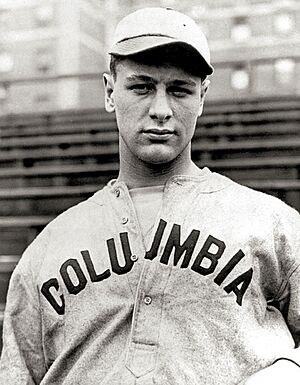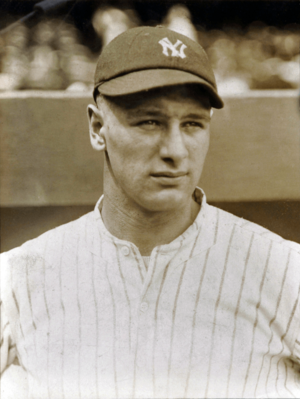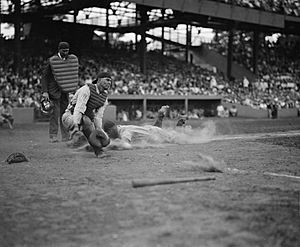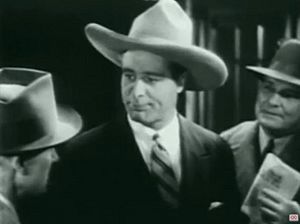Lou Gehrig facts for kids
Quick facts for kids Lou Gehrig |
|||
|---|---|---|---|
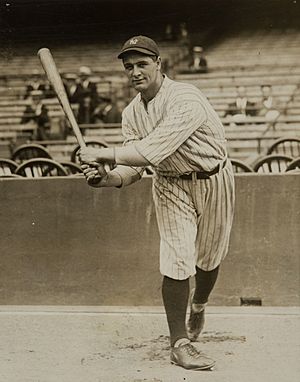
Gehrig with the New York Yankees in 1923
|
|||
| First baseman | |||
| Born: June 19, 1903 Yorkville, Manhattan, New York City, U.S. |
|||
| Died: June 2, 1941 (aged 37) Riverdale, Bronx, New York City, U.S. |
|||
|
|||
| debut | |||
| June 15, 1923, for the New York Yankees | |||
| Last appearance | |||
| April 30, 1939, for the New York Yankees | |||
| MLB statistics | |||
| Batting average | .340 | ||
| Hits | 2,721 | ||
| Home runs | 493 | ||
| Runs batted in | 1,995 | ||
| Teams | |||
|
|||
| Career highlights and awards | |||
|
|||
| Induction | 1939 | ||
| Vote | Special Election | ||
Henry Louis Gehrig (born Heinrich Ludwig Gehrig; June 19, 1903 – June 2, 1941) was an American professional baseball first baseman. He played 17 seasons in Major League Baseball (MLB) for the New York Yankees from 1923 to 1939. Gehrig was famous for being a great hitter and for how tough he was. This earned him the nickname "the Iron Horse". Many people think he is one of the best baseball players ever.
He was an All-Star seven times in a row. He won the Triple Crown once and was the American League (AL) Most Valuable Player twice. He was also part of six World Series championship teams. His career batting average was .340. He hit 493 home runs and had 1,995 runs batted in (RBI).
In 1939, he was chosen for the Baseball Hall of Fame. He was the first MLB player to have his uniform number (4) retired by a team. Gehrig set several major-league records. This included the most career grand slams (23), though this record was later broken. He also held the record for most consecutive games played (2,130). This record stood for 56 years until Cal Ripken Jr. broke it in 1995.
Gehrig's amazing streak ended on May 2, 1939. He chose to stop playing because he was feeling weak. Doctors later found out he had amyotrophic lateral sclerosis, a serious illness. This disease is now often called "Lou Gehrig's disease" in North America. The illness forced him to stop playing at age 36. He passed away two years later. His famous 1939 "Luckiest Man on the Face of the Earth" speech at Yankee Stadium was a very emotional moment.
In 1969, baseball writers voted Gehrig the best first baseman of all time. Fans also chose him as the top vote-getter for the Major League Baseball All-Century Team in 1999. There is a monument in his honor at Monument Park at Yankee Stadium. The Lou Gehrig Memorial Award is given each year to an MLB player who shows Gehrig's honesty and good character.
Contents
Early Life and Baseball Start
Lou Gehrig was born on June 19, 1903, in Yorkville, Manhattan, New York City. He was the second of four children born to German immigrant parents. His mother, Christina, was the main person earning money for the family. Lou was the only one of his siblings to live past childhood. His two sisters died young from whooping cough and measles, and a brother also died as a baby. From a young age, Lou helped his mother with chores. He spoke German at home and didn't learn English until he was five years old.
Gehrig first became known for his baseball skills in 1920. He was playing in a game in Chicago when he was just 17. He hit a grand slam that went completely out of the major league park. This was an amazing feat for someone his age.
Gehrig went to Commerce High School and then studied engineering at Columbia University. He was recruited to play football there and later joined the baseball team. A scout for the New York Yankees, Paul Krichell, noticed Gehrig's powerful left-handed hitting. Krichell saw Gehrig hit some of the longest home runs on college campuses. Gehrig signed a contract with the Yankees on April 30, 1923.
He played for the minor-league Hartford Senators for parts of two seasons. After that, Gehrig played his entire baseball career with teams based in New York City.
Major League Career
Joining the New York Yankees (1923–1939)
Lou Gehrig joined the New York Yankees during the 1923 season. He made his first major-league appearance as a pinch hitter on June 15, 1923, when he was 19 years old. For his first two seasons, he didn't play much because Wally Pipp was the regular first baseman. Pipp was a strong hitter for the Yankees.
In 1925, Gehrig started playing more often at first base. He had a good season, batting .295 with 20 home runs. In 1926, at age 23, Gehrig had a breakout season. He batted .313 and led the American League with 20 triples. He also had 16 home runs and 112 RBIs. In the 1926 World Series against the St. Louis Cardinals, Gehrig hit .348. However, the Cardinals won the series.
Amazing 1927 Season
In 1927, Gehrig had one of the best seasons ever for a batter. He hit .373 with 47 home runs and a record 175 RBIs. His great hitting helped the 1927 Yankees win 110 games. They won the AL pennant and swept the Pittsburgh Pirates in the World Series.
Even though he was named the league MVP, Gehrig's achievements were often overshadowed by his teammate Babe Ruth. Ruth hit a record 60 home runs that year. The 1927 Yankees team, known as "Murderers' Row," is often called the greatest lineup of all time.
Uniform Number 4
In 1929, the New York Yankees started wearing numbers on their uniforms. Gehrig wore number 4. This was because he usually batted fourth in the lineup, right after Babe Ruth, who batted third.
Four Home Runs in One Game
In 1932, Gehrig made history by becoming the first player in the 20th century to hit four home runs in a single game. This happened on June 3 against the Philadelphia Athletics. He almost hit a fifth home run, but an opposing player caught it.
Consecutive Games Streak
On August 17, 1933, Gehrig played in his 1,308th consecutive game. This broke the record for the longest streak of games played. The previous record was held by Everett Scott.
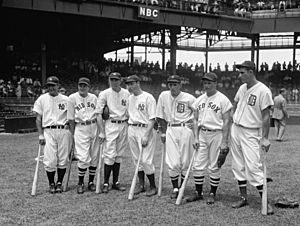
During this streak, sportswriters gave Gehrig the nickname "the Iron Horse" in 1931. Gehrig managed to keep the streak going even when he was hurt. For example, in 1933, a pitch hit him in the head, but he stayed in the game. In 1934, he was hit by a pitch above his eye and was knocked out for a few minutes. He still played the next day.
Gehrig's record of 2,130 consecutive games lasted for 56 years. Baltimore Orioles shortstop Cal Ripken Jr. broke it on September 6, 1995. Ripken eventually played 2,632 consecutive games.
Triple Crown Winner
On April 30, 1934, Gehrig hit his 300th home run. He was only the second player after Babe Ruth to reach this milestone. In 1934, Gehrig won the American League Triple Crown. This means he led the league in three important batting categories: home runs (49), RBIs (166), and batting average (.363).
Illness and Retirement
By the end of the 1938 season, Gehrig started feeling tired and weaker. His performance on the field was not as strong as before. When the 1939 season began, his power was gone. He struggled with basic plays and his coordination was worse.
By late April, his batting average was very low. On April 30, he played his 2,130th consecutive game. On May 2, 1939, Gehrig told his manager, Joe McCarthy, that he was taking himself out of the lineup. He said it was "for the good of the team." This ended his incredible 14-year streak. Fans and players were shocked. The Detroit Tigers' fans gave Gehrig a standing ovation as he sat on the bench. He stayed with the Yankees as team captain for the rest of the season but never played in a major-league game again.
Diagnosis of ALS
As Gehrig's health got worse, his wife, Eleanor, contacted the Mayo Clinic in Rochester, Minnesota. Gehrig went to the clinic on June 13, 1939. After six days of tests, doctors confirmed the diagnosis of amyotrophic lateral sclerosis (ALS) on June 19, 1939. This was Gehrig's 36th birthday. The doctors told his wife that ALS would cause increasing paralysis and make it hard to swallow and speak. They said he would likely live less than three more years. His mind, however, would remain clear.
After his visit to the Mayo Clinic, Gehrig rejoined the Yankees briefly. As his train arrived, he saw a group of Boy Scouts waving and wishing him luck. Gehrig waved back, but quietly told his friend, "They're wishing me luck — and I'm dying."
Farewell and Number Retirement
 |
|
| Lou Gehrig's number 4 was retired by the New York Yankees in 1939. |

The Yankees announced Gehrig's retirement on June 21, 1939. They quickly planned a special day to honor him. On Tuesday, July 4, 1939, "Lou Gehrig Appreciation Day" was held at Yankee Stadium. More than 61,000 fans came to the ceremony. Important people and former teammates praised Gehrig. New York mayor Fiorello La Guardia called Gehrig a "perfect example of the best sportsmanship and citizenship."
Yankees manager Joe McCarthy, a close friend, struggled to speak. He called Gehrig "the finest example of a ballplayer, sportsman, and citizen that baseball has ever known." The Yankees then retired Gehrig's uniform number 4. He was the first player in Major League Baseball history to receive this honor. Gehrig received many gifts, including a silver trophy from his teammates. It had a poem written by a New York Times writer.
"The Luckiest Man on the Face of the Earth"
On July 4, 1939, Lou Gehrig gave a famous speech at Yankee Stadium. It is often called "baseball's Gettysburg Address." Gehrig usually avoided public speaking, but the crowd cheered for him to speak. He had memorized some sentences.
The crowd stood and applauded for almost two minutes. Gehrig was very emotional and wiped tears from his face. His former teammate, Babe Ruth, hugged him. The crowd chanted, "We love you, Lou!" The New York Times called it "one of the most touching scenes ever witnessed on a ball field."
Later Life and Legacy
Gehrig played his last game on April 30, 1939. After retiring, he wrote that he was not sad about his condition. He said he would "hold on as long as possible" and accept what came.
In October 1939, he became a New York City parole commissioner. He visited prisons and helped people. His wife, Eleanor, often helped him sign official papers as his condition worsened. He quietly resigned from the job about a month before he passed away.
Death
Lou Gehrig passed away at his home in Riverdale, Bronx, New York, on June 2, 1941. He was 37 years old, just 17 days before his 38th birthday. When they heard the news, Babe Ruth and his wife went to comfort Eleanor. Flags in New York and at major-league ballparks were lowered to half-staff.
Thousands of people came to see Gehrig's body. Babe Ruth was among them and cried. Gehrig's remains were cremated on June 4 at Kensico Cemetery in Valhalla, New York. Eleanor never remarried. She said, "I had the best of it. I would not have traded two minutes of my life with that man for 40 years with another." She spent the rest of her life supporting ALS research. She passed away 43 years after Gehrig and was buried with him.
Statistical Achievements
Gehrig was one of the best run producers in baseball history. He had 509 RBIs in three seasons from 1930 to 1932. He had 13 seasons in a row with 100 or more RBIs, which is a major-league record.
Gehrig batted .350 or better in six seasons. He led the American League in runs scored four times, home runs three times, and RBIs five times. His 185 RBIs in 1931 are still the American League record. He also holds the record for most seasons with 400 or more total bases, doing this five times.
Hall of Fame
In December 1939, Lou Gehrig was elected to the Baseball Hall of Fame. This was a special election because of his illness. At 36, he was the youngest player to be honored at that time.
Monument and Plaques
The Yankees put a monument to Gehrig in center field at Yankee Stadium on July 6, 1941. It called him "A man, a gentleman and a great ballplayer whose amazing record of 2,130 consecutive games should stand for all time."
There are also plaques in New York City where Gehrig lived. His home in Riverdale, Bronx, is marked by a plaque.
Lou Gehrig Memorial Award
The Lou Gehrig Memorial Award is given every year to an MLB player. This player must show the same good character and honesty as Gehrig, both on and off the field. The award was created by the Phi Delta Theta fraternity, which Gehrig was a member of at Columbia University. It was first given out in 1955.
Lou Gehrig Day
In March 2021, Major League Baseball announced that June 2 would be Lou Gehrig Day. This date was chosen because it's the anniversary of when Gehrig became the Yankees' starting first baseman in 1925 and when he passed away in 1941.
Records, Awards, and Accomplishments
Sixty years after his farewell, Gehrig received the most votes of any baseball player for the Major League Baseball All-Century Team in 1999. Sporting News also ranked Gehrig sixth on their list of "Baseball's 100 Greatest Players."
Records
| Accomplishment | Record | Refs |
|---|---|---|
| Most consecutive seasons with 120+ RBIs | 8 (1927–1934) | |
| Highest on-base percentage by a first baseman | .447 | |
| Highest slugging percentage by a first baseman | .632 | |
| Most extra base hits by a first baseman | 1,190 | |
| Single–season | ||
| Most runs batted-in by a first baseman | 184 (1931) | |
| Most runs scored by a first baseman | 167 (1936) | |
| Highest slugging percentage by a first baseman | .765 (1927) | |
| Extra-base hits by a first baseman | 117 (1927) | |
| Most total bases by a first baseman | 447 (1927) | |
| Single–game | ||
| Most home runs | 4 | |
Awards and Honors
| Award/Honor | No. of times | Dates | Refs |
|---|---|---|---|
| American League All-Star | 7 | 1933–1939 | |
| American League MVP | 2 | 1927, 1936 | |
| Named starting first baseman on the Major League Baseball All-Century Team | — | 1999 | |
| Inducted into National Baseball Hall of Fame and Museum | — | 1939 | |
| World Series champion | 6 | 1927, 1928, 1932, 1936, 1937, 1938 |
Other Accomplishments
| Accomplishment | Year |
|---|---|
| Triple Crown (.363 BA, 49 HR, 165 RBI) | 1934 |
| Only player in history to collect 400 total bases in five seasons | 1927, 1930, 1931, 1934, 1936 |
| With Stan Musial, one of two players to collect at least 500 doubles, 150 triples, and 450 home runs in a career | – |
| One of only four players (with Babe Ruth, Stan Musial, and Ted Williams) to end career with a minimum .330 batting average, 450 home runs, and 1,800 RBI | – |
| With Albert Pujols, one of two players to hit 40 doubles and 40 home runs in the same season three separate times | 1927, 1930, 1934 |
| Scored game-winning run in eight World Series games | – |
| First athlete ever to appear on a box of Wheaties | – |
| First baseball player to have his uniform number retired; his July 4, 1939, farewell speech was voted by fans as the fifth-greatest moment in Major League Baseball history in 2002 | July 4, 1939 |
| The Lou Gehrig Memorial Trophy was awarded to the most valuable player in the annual Hearst Sandlot Classic. | 1946 - 1965 |
| A Lou Gehrig 25-cent postage stamp was issued by the U.S. Postal Service on the 50th anniversary of his retirement from baseball. | 1989 |
| On the 70th anniversary of his farewell address in Yankee Stadium, MLB dedicated a day of remembrance to him and to the awareness of ALS | July 4, 2009 |
| Gehrig was mentioned in the poem "Line-Up for Yesterday" by Ogden Nash. |
Film and Other Media
Gehrig starred as himself in the 1938 movie Rawhide. This was his only feature film role.
His life story was told in the 1942 film The Pride of the Yankees. Gary Cooper played Gehrig, and Teresa Wright played his wife. The movie received 11 Academy Award nominations. Some of Gehrig's former Yankee teammates, like Babe Ruth and Bill Dickey, played themselves in the film. In 2008, The Pride of the Yankees was named the third-best sports movie ever made.
There was also a 1978 TV movie called A Love Affair: The Eleanor and Lou Gehrig Story. It was based on Eleanor Gehrig's autobiography.
Images for kids
- Home run records
- Career home run leaders
- Batting champions
- Doubles records
- Annual doubles leaders
- Annual triples leaders
- Annual home run leaders
- Annual runs scored leaders
- Annual RBI leaders
- RBI records
- Players who spent their entire career with one franchise
- Career triples leaders
- Career doubles leaders
- Career RBI leaders
- Career runs scored leaders
- Career hits leaders
- List of Major League Baseball career total bases leaders
- List of Major League Baseball players to hit for the cycle
- MLB titles leaders
See also
 In Spanish: Lou Gehrig para niños
In Spanish: Lou Gehrig para niños


